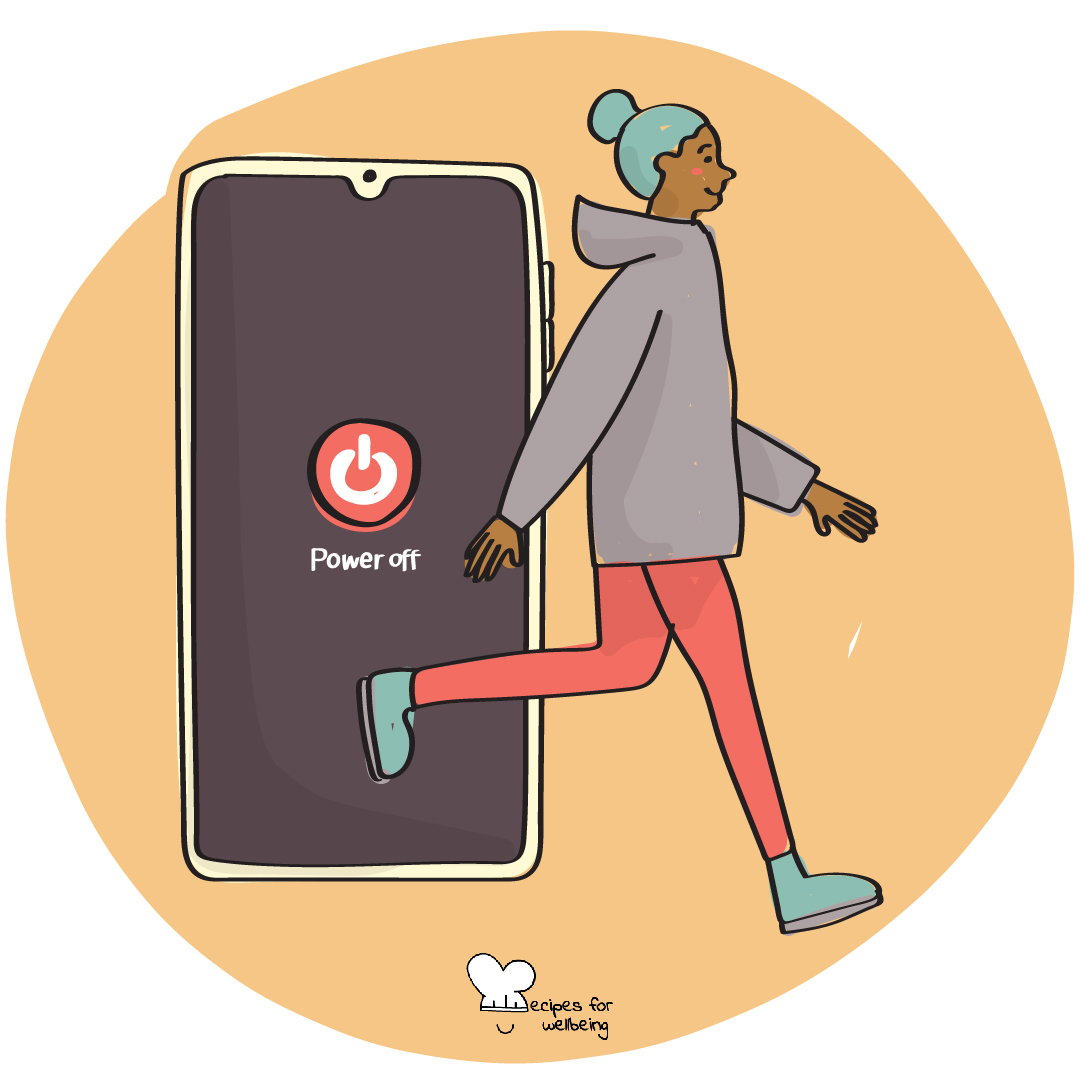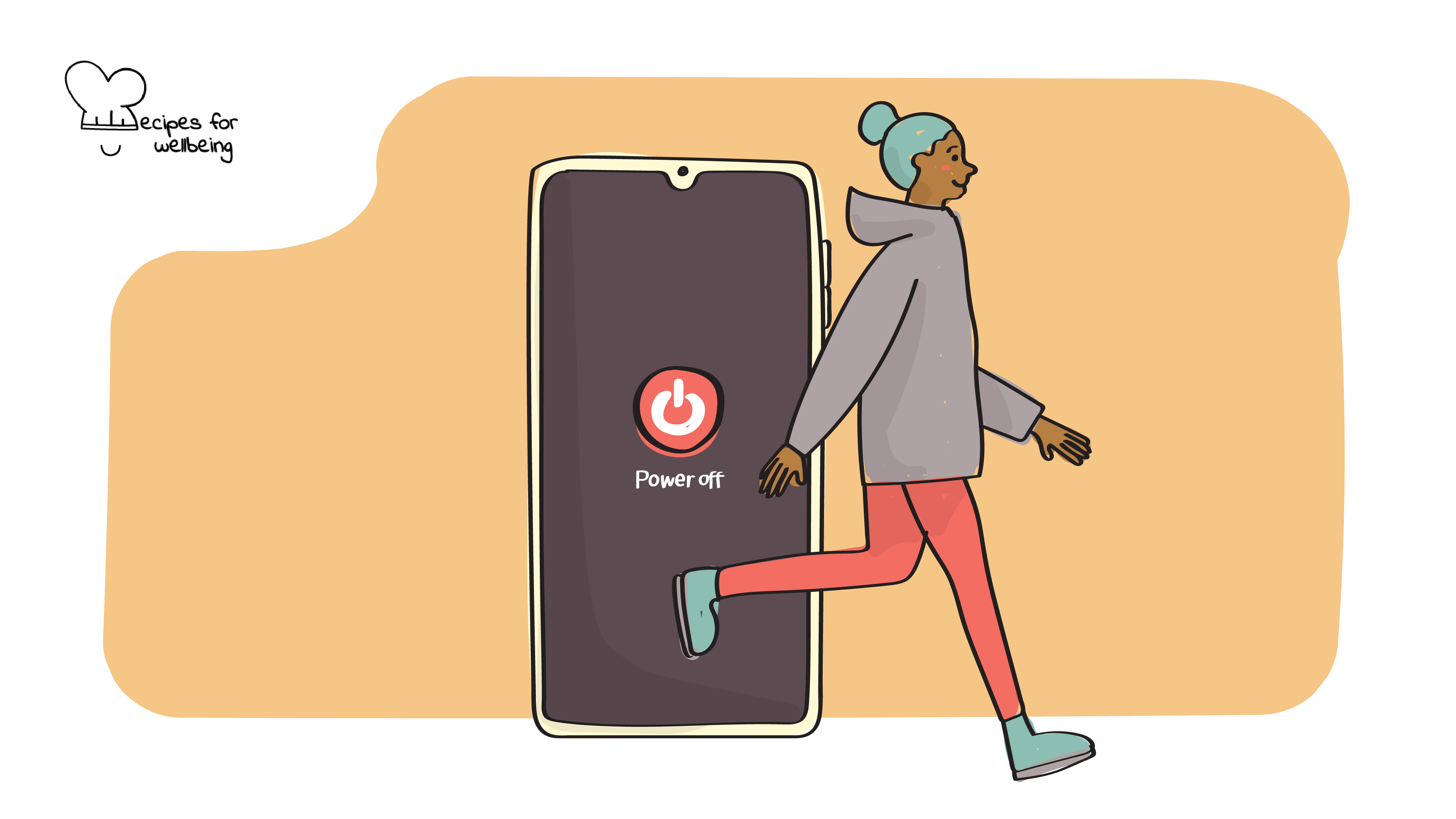
11 ways to improve digital boundaries
Sometimes, our stop doing list needs to be bigger than our to-do list. —Patti Digh
👥 Serves: 1 person
🎚 Difficulty: Medium
⏳ Total time: Ongoing
🥣 Ingredients: Willingness, a smartphone, pen and paper
💪 Nutritional values: Productivity, Connectedness, Self-Awareness, Compassion, Presence

11 ways to improve digital boundaries
📝 Description
Create healthy boundaries and improved digital habits.
One of the gentlest and kindest things we can do for ourselves is build firm boundaries in our lives, as a way of protecting our emotional, mental, and physical health.
Normally, when we consider boundaries, we think about saying “no”. Let’s try reframing that mind set: by saying no, we are making more time to say “yes” to doing the things we love, that challenge us in new ways and bring excitement into our life. It also invites us to be more mindfully present in the moment.
Now imagine how much more “yes” time you could have with a digital detox? The average person spends between 3.5–4.5 hours per day on their smartphones, divided between social media platforms, reading the news, scrolling the web, and playing games.
This is not a recipe that suggests getting rid of your phone, but instead being intentional and mindful about using the phone as a positive addition to your life by creating healthy digital boundaries that are sustainable – not a cold turkey attempt but rather definitive digital boundaries to free up your precious time.
You may also be interested in reading our recipe “Building a conscious relationship with your phone” if you would like to first reflect on the quality of your relationship with your phone. And if you realise that at the moment, digital devices keep you on a short leash, why not try out our recipe “Take control of your life with a digital detox”?
This recipe has been inspired by the work of writer Becca Caddy in her article posted in the Guardian by our wellbeing content writer collaborator Marissa Del Mistro.
👣 Steps
Step 1 – Establish your digital boundaries (~1 hour)
There are plenty of ways you can establish your digital boundaries. Think of it as a fun challenge to yourself and consider 1 of these 11 options:
- Establish tech-free dinners during the week. Get the people/family you live with to join you.
- Buy an “old-school” alarm clock and charge your phone outside of the bedroom to avoid late night scrolling.
- Disable “read receipts” for your messages. If you have the urge to reply to someone immediately whenever you get a message, reduce the pressure by disabling the read receipts so people cannot tell when you have read their messages nor when they read yours.
- Overwhelmed by the stress of the news? Alleviate that by deleting the news apps on your phone and making it a desktop only experience and try downloading the useful “News Feed Eradicator” on Chrome, which replaces news with an inspirational quote. When/if you feel ready to add news back to your routine, try getting your information from a podcast such as “BBC Global News Podcast”, which updates twice a day and delivers the news in under 30 minutes – the perfect time for a stroll, cooking, cleaning, or even something creative while listening.
- Set up a timer for your social media apps like TikTok – while fun for a little while, time ceases to exist while scrolling and suddenly it’s been an hour. TikTok has a timer function built into the app which locks users until the time limit is reached. When you do reach the time, you have to put in a passcode so if you want an added challenge, ask a trusted friend to create the passcode, forcing you to wait until the next day.
- Turn off notifications. When a phone pings it’s too tempting to have a look, so remove the temptation by removing notifications for messages and apps that don’t require your immediate attention.
- Curate your social media with our recipe “Controlling your social media feeds”. When you do use your social media, you should be seeing people and ideas who spark joy, leave you feeling inspired and motivated – not people who make you feel low or bad about yourself. If you feel like you might offend someone by deleting them, you can mute them on most platforms – and they’ll never know.
- Leave your phone at home once a week, even if it’s just while you go for dinner.
- Unsubscribe from emails that are no longer important, to declutter your inbox.
- Use the preferences to your advantage. Some new devices have preferences like ‘do not disturb’, ‘personal’, and ‘sleep’, which you can set to different time limits that will mute all of your notifications for a period of time.
- Have a phone-free morning routine.
Step 2 – Replacement (ongoing)
With all your newly bought time back, you can work on replacing it with positive, exciting things. Why not use this time to get out in nature, cook, read a new book, have a picnic with friends, play a board game, learn to play an instrument, journal, join an exercise class, learn calligraphy – whatever you want!
Step 3 – Digital goodness (ongoing)
Rebuild your relationship with your phone by keeping up the digital detox ongoing and adding positive apps that will bring joy into your life. Some excellent, free apps for self-improvement and joy are:
- Action for Happiness – Daily nudges with an action idea to boost your happiness based on their popular monthly calendars.
- Duolingo – Replace scrolling for learning a new language.
- Grateful – A prompt-based journal focused on gratitude.
- Insight Timer – Insight timer is an incredible resource for meditation, yoga and mindfulness.
- Mantra – Daily affirmations that ping right to your phone daily.
- MindShift CBT – Offers meditation, journals, coping cards and activities to help you face fears and develop healthy habits.
- Moodfit – Helps you to track your moods and gives you exercises to help address negative emotions.
- No Zero Days – Divides your day into four steps: created, helped, learned, and dealt, so whenever you do something towards these themes, you can tap the corresponding button to stay motivated.
- TED – TED app offers more than 3,000 inspiring talks in more than 20 languages, to offer motivation and inspiration from incredible speakers around the world.
- ThinkUp – Daily affirmations to use or create your own that you can even set to music and set reminders to focus on them.
Discover more apps in our recipe “Digital goodies”.
Step 4 – Reflect on your new digital boundaries (1.5 hours)
When implementing change of any kind, it’s important to reflect on the outcomes. With a pen and paper, set some time aside to reflect on how your relationship with your phone, with yourself and with others has changed.
How does your newly curated social media page make you feel? How are your anxiety levels? What are your phone-free mornings like? What conversations have you had without phones to distract you over dinner? What are your concentration levels like? Have you managed to achieve any goals you’ve been putting off?

